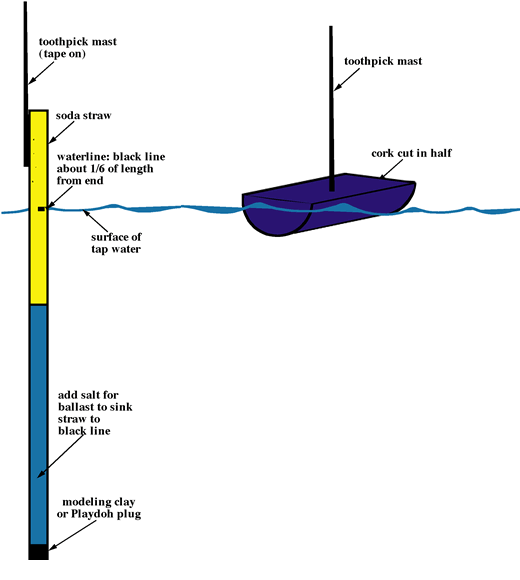Follow these directions to make a working scale model of Scripps's Floating Instrument Platform and a regular surface boat so you can compare how they behave at sea.
What You Will Need:
FLIP: drinking straw, toothpick, clear tape, clay or Play-Doh, salt, permanent marker, two paper plates
BOAT: cork cut in half as shown, toothpick
TANK: 2-liter soda bottle with top cut off, or an old aquarium, or a bucket.
What To Do:
Construction:
FLIP :
1. Estimate the lengthwise center of the straw and mark it with a permanent marker.
2. Looking at one half of the straw, estimate thirds (three pieces), mark the thirds with a permanent marker.
3. Make the last mark closest to the end of the straw a bigger line than the others. This is the "waterline."
4. Write "FLIP" on the side of the straw near the same end.
5. Tape a toothpick mast to the same end.
6. Plug the other end with clay or Play-Doh.
7. Fill the interior of the straw with salt to a little more than 1/2 full. A paper plate folded in half makes it easier to pour the salt into the straw.
8. Your FLIP should float with the waterline at the
surface. Add or remove salt in small amounts to trim the depth (make the waterline mark on FLIP match the surface of the water). Be careful not to let FLIP sink too low and flood!
BOAT:
1. Cut the cork in half lengthwise. (This is a good job for a grown-up!)
2. Press the toothpick into the cork to be a mast, as shown.
CONTAINER:
You have some choices here.
You can use a 2 liter soda bottle and remove the top, or a home aquarium, a bucket, a large flower vase, your tub, a pond, or even a pool. A clear container is good because you can see what is happening below the surface.
Operation:
Make surface waves by bobbing your fingers or a flat spoon up and down on the water's surface. Watch the two masts move. What do you observe? Which ship would you rather be on? Surface waves don't affect the largest portion of FLIP down deep, so FLIP doesn't rock like a cork!
Understanding Your Results:
Science Lessons: Try floating FLIP in different liquids like salt water, vinegar, or vegetable oil. Is the waterline mark above or below the surface? What would happen if FLIP drifted from the salt water of the ocean into the fresh water of a river flowing to the ocean?
Engineering Lessons: There are many kinds of models. Because your model is smaller than the real FLIP, it is a scale model. Because it behaves in the same way, it is a working model. A computer simulation is an animation based on rules given a computer. There's more about FLIP on the FLIP website: http://www.mpl.ucsd.edu/resources/flip.intro.html .
Advantages of FLIP: Scientists doing sound-in-the-sea experiments like using FLIP; it is a lot quieter than other boats because it doesn't move so much. Scientists who study surface waves prefer FLIP because it gives them an experimental platform that is not affected by what they are trying to measure.
